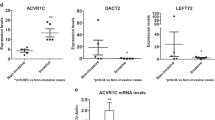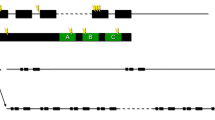Abstract
The inhibitor of DNA binding 2 (Id2) basic helix-loop-helix protein interacts genetically and physically with the pocket proteins (Rb, p107 and p130) and has been implicated as an oncogene. In other studies, however, Id2 has been shown to function as a tumor suppressor. Here, we studied the role of Id2 in a well characterized model of ocular cancer in which the three pocket proteins are inactivated by generating mice lacking one or both Id2 alleles. Id2 deficiency had no impact on tumorigenesis in the eye. Unexpectedly, however, Id2 loss significantly increased the rate of metastasis. Liver metastases in Id2 heterozygotes demonstrated significant decrease of Id2 expression and loss of the remaining Id2 allele, strongly suggesting that Id2 inactivation specifically was required for metastasis in this model. These findings provide new insights into the role of Id2 in metastasis.




Similar content being viewed by others
Abbreviations
- Id2:
-
Inhibitor of DNA binding 2
- Rb:
-
Retinoblastoma
- bHLH:
-
Basic helix-loop-helix
- SV40:
-
Simian virus 40
- TAg:
-
Large and small tumor antigens
- RPE:
-
Retinal pigment epithelium
- gDNA:
-
Genomic DNA
- VEGF:
-
Vascular endothelial growth factor
References
Sun XH, Copeland NG, Jenkins NA et al (1991) Id proteins Id1 and Id2 selectively inhibit DNA binding by one class of helix-loop-helix proteins. Molec Cell Biol 11:5603–5611
Lasorella A, Iavarone A, Israel MA (1996) Id2 specifically alters regulation of the cell cycle by tumor suppressor proteins. Molec Cell Biol 16:2570–2578
Lee EY, Chang CY, Hu N et al (1992) Mice deficient for Rb are nonviable and show defects in neurogenesis and haematopoiesis. Nature 359(6393):288–894
Lasorella A, Noseda M, Beyna M et al (2000) Id2 is a retinoblastoma protein target and mediates signaling by Myc oncoproteins. Nature 407(6804):592–598
Lasorella A, Rothschild G, Yokota Y et al (2005) Id2 mediates tumor initiation, proliferation, and angiogenesis in Rb mutant mice. Mol Cell Biol 25(9):3563–3574
Itahana Y, Singh J, Sumida T et al (2003) Role of Id-2 in the maintenance of a differentiated and noninvasive phenotype in breast cancer cells. Cancer Res 63(21):7098–7105
Russell RG, Lasorella A, Dettin LE et al (2004) Id2 drives differentiation and suppresses tumor formation in the intestinal epithelium. Cancer Res 64(20):7220–7225
Onken MD, Ehlers JP, Worley LA et al (2006) Functional gene expression analysis uncovers phenotypic switch in aggressive uveal melanomas. Cancer Res 66(9):4602–4609
Zalvide J, Stubdal H, DeCaprio JA (1998) The J domain of simian virus 40 large T antigen is required to functionally inactivate RB family proteins. Mol Cell Biol 18(3):1408–1415
Syed NA, Windle JJ, Darjatmoko SR et al (1998) Transgenic mice with pigmented intraocular tumors: tissue of origin and treatment. Invest Ophthalmol Vis Sci 39(13):2800–2805
Yokota Y, Mansouri A, Mori S et al (1999) Development of peripheral lymphoid organs and natural killer cells depends on the helix-loop-helix inhibitor Id2. Nature 397:702–706
Windle JJ, Albert DM, O’Brien JM et al (1990) Retinoblastoma in transgenic mice. Nature 343(6259):665–669
Bradl M, Klein-Szanto A, Porter S et al (1991) Malignant melanoma in transgenic mice. Proc Natl Acad Sci USA 88(1):164–168
Ikawa T, Fujimoto S, Kawamoto H et al (2001) Commitment to natural killer cells requires the helix-loop-helix inhibitor Id2. Proc Natl Acad Sci USA 98(9):5164–5169
Virgili G, Gatta G, Ciccolallo L et al (2008) Survival in patients with uveal melanoma in Europe. Arch Ophthalmol 126(10):1413–1418
Tsunedomi R, Iizuka N, Tamesa T et al (2008) Decreased ID2 promotes metastatic potentials of hepatocellular carcinoma by altering secretion of vascular endothelial growth factor. Clin Cancer Res 14(4):1025–1031
Kowanetz M, Valcourt U, Bergstrom R et al (2004) Id2 and Id3 define the potency of cell proliferation and differentiation responses to transforming growth factor beta and bone morphogenetic protein. Mol Cell Biol 24(10):4241–4254
Acknowledgments
This research was supported by R01 EY1316905 from the National Eye Institute, Knights Templar Foundation, Research to Prevent Blindness, Horncrest Foundation (JWH), and departmental grants from Research to Prevent Blindness and National Eye Institute Vision Core Grant P30 EY 02687. The authors thank the Immunomorphology Core Lab for preparation of histopathologic sections.
Author information
Authors and Affiliations
Corresponding author
Rights and permissions
About this article
Cite this article
Agapova, O.A., Person, E. & Harbour, J.W. Id2 deficiency promotes metastasis in a mouse model of ocular cancer. Clin Exp Metastasis 27, 91–96 (2010). https://doi.org/10.1007/s10585-010-9304-5
Received:
Accepted:
Published:
Issue Date:
DOI: https://doi.org/10.1007/s10585-010-9304-5




